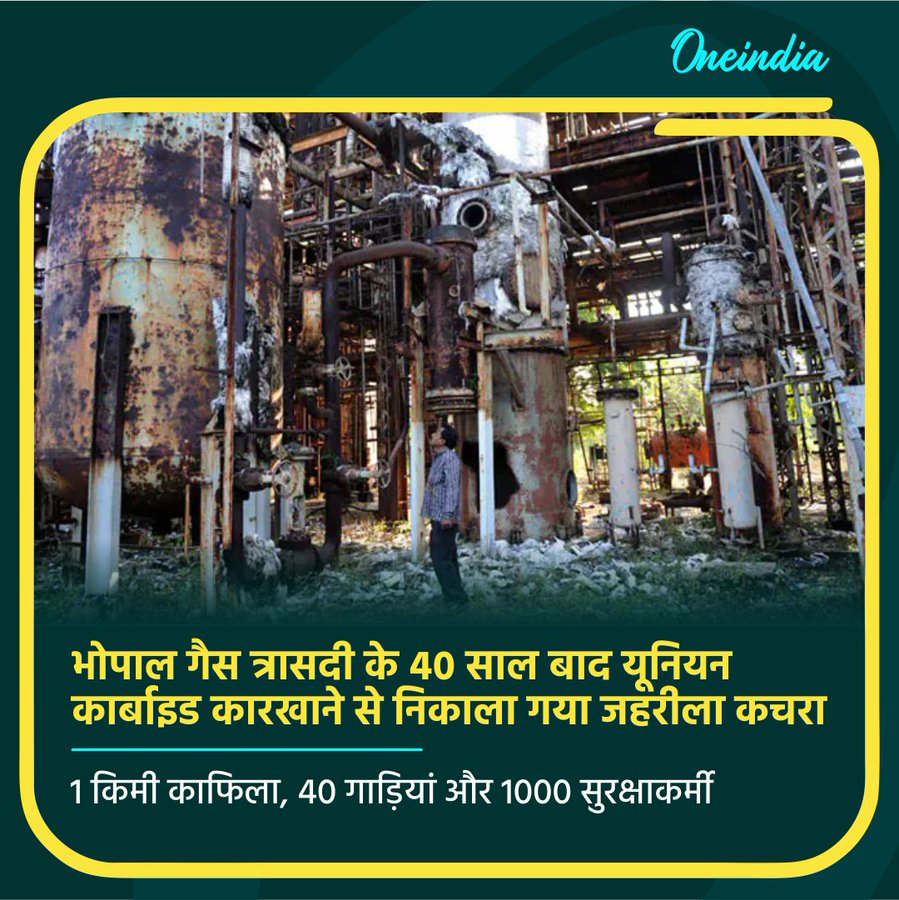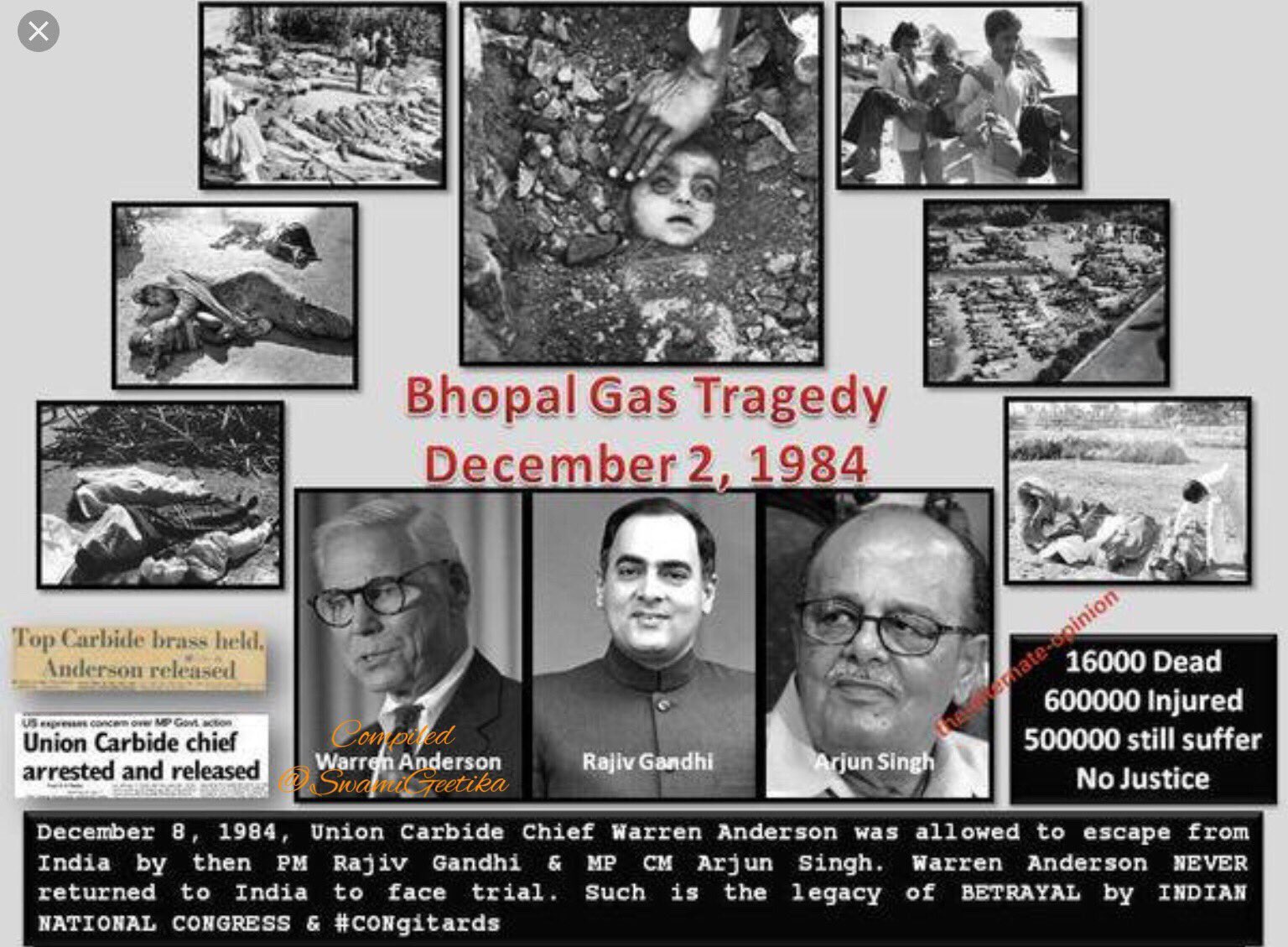Four decades later, the toxic legacy of the Bhopal Gas Tragedy is finally being addressed. In the wake of the 1984 disaster that claimed thousands of lives and left many more with lasting health issues, the remnants of deadly chemicals still plagued the city.
The long-overdue removal of the toxic waste left behind is underway in Madhya Pradesh. While Warren Anderson, the then CEO of Union Carbide, remains free – the Bhopal Gas Tragedy is a symbol of corporate negligence that teaches important lessons to the rising Bharat of today!
Bhopal Gas Tragedy – Toxic Waste Finally Removed
After 40 years, Bhopal finally cleared of toxic waste from 1984 gas tragedy.#BhopalGasTragedy pic.twitter.com/nduFzKXqp3
— The Tatva (@thetatvaindia) January 2, 2025
Forty years after the catastrophic Bhopal Gas Tragedy, the 377 tons of hazardous waste is finally being removed. The toxic waste is being shifted from the defunct Union Carbide factory to the Pithampur industrial area for disposal. This long-delayed action was prompted by the Madhya Pradesh High Court’s stern warning to authorities, demanding immediate action after decades of inertia.
1984 में हुए भोपाल गैस त्रासदी का जहरीला कचरा देर रात ग्रीन कॉरिडोर बनाकर इंदौर के पीथमपुर भेजा गया।
40 साल बाद यूनियन कार्बाइड के इस कचरे को भोपाल से हटाया गया।#BhopalGasTragedy #unioncarbide pic.twitter.com/uLw52SWt74
— प्रतीक यादव (@prateek_ky) January 2, 2025
The toxic waste is being transported in 12 sealed container trucks under high security, accompanied by police escorts, ambulances, and fire engines.
Swatantra Kumar Singh, Director of the Bhopal Gas Tragedy Relief and Rehabilitation Department, stated that extensive safety measures were in place to prevent pollution during the packing, transportation, and incineration process.

- Workers are working 30-minute shifts to pack the hazardous waste. They are given extensive health check-ups to ensure safety.
- A green corridor has been set up for the safe transportation of the Bhopal Gas Tragedy waste.
- If the schedule does not suffer any undue delay, the waste shall be incinerated in 3 months’ time.
- The smoke from the incinerator will pass through 4 stages of advanced filters to ensure environmental safety.
- The ash will be buried securely to prevent any contact with soil or water.
BREAKING NEWS🚨
Toxic waste from the 1984 Bhopal Gas Tragedy site (Union Carbide factory) has been shifted for disposal after 40 years🔥
MP CM Mohan Yadav⚡️: Around 358 metric tons of hazardous waste has been removed from Bhopal.
For the last 40 years, the people of Bhopal… pic.twitter.com/We5EuAKUkk
— Political Views (@PoliticalViewsO) January 2, 2025
Despite these assurances, protests erupted in Pithampur, with locals fearing contamination based on previous experiences in 2015. That year, a trial incineration allegedly polluted nearby areas. Since then tests proved that the incineration is safe for humans as well as the environment. However, activists warn that the current waste removal is merely the tip of the iceberg, as over a million tons of toxic soil and waste continue to pollute Bhopal’s groundwater.
#BhopalGasTragedy: After 40 Years, #Bhopal Rid Of Toxic Waste From 1984 Gas Tragedy#DNAVideos
For more videos, click here https://t.co/6ddeGFqedQ pic.twitter.com/uCquXjAOKq
— DNA (@dna) January 2, 2025
Flashback – The Night That Changed Bhopal Forever
भोपाल गैस कांड…
त्रासदी या सामूहिक हत्याकांड!#BhopalGasTragedy pic.twitter.com/isgusuR0WH— BJP (@BJP4India) December 2, 2023
On the fateful night of December 2-3, 1984, a lethal cloud of methyl isocyanate (MIC) gas leaked from the Union Carbide pesticide factory in Bhopal. This poisonous cloud enveloped the city in death and despair. Within hours, thousands perished in their sleep, and the aftermath saw over 15,000 lives claimed by the disaster. Some activists estimate the toll to be even higher. The gas leak is beleived to be directly resposnible for over 500,000 deaths!
Yesterday, I posted how Rajiv Ghandy, reportedly, facilitated rescue of Warren Anderson…main accused in Bhopal Gas Leak Disaster!
Today, let me give brief on HOW CORPORATE GREED LEFT THOUSANDS SUFFERING & CONgress FAILED POOR CITIZENS IN GETTING FAIR COMPENSATION TOO!
On… pic.twitter.com/STZpDCDUDG
— BhikuMhatre (@MumbaichaDon) December 3, 2024
The gas’s corrosive effects left survivors with chronic respiratory problems, cancers, and severe birth defects in subsequent generations.
The Union Carbide factory’s neglect was the root cause. A series of safety protocols were ignored. Moreover, the MIC storage tanks were inadequately maintained. On that dreadful night, water entered one of the tanks, triggering a runaway chemical reaction. As pressure built, safety systems failed to activate. Hence, 40 tons of MIC escaped into the air. The plant’s proximity to densely populated neighborhoods magnified the scale of the tragedy.
Who Is the Real Culprit? – Warren Anderson
More than 20000 citizens of India were choked to death in Bhopal Gas Tragedy in a single night.
Can @RahulGandhi tell us why his father let Warren Anderson be escorted out of India within few hours of the Tragedy ?
What was the hurry ? pic.twitter.com/lbzvVPQbqS
— Kashmiri Hindu (@BattaKashmiri) December 2, 2024
At the heart of the Bhopal Gas Tragedy lies a name that has become synonymous with corporate impunity: Warren Anderson. Anderson was the then-Chairman and CEO of Union Carbide Corporation (UCC). Under his leadership, the cost-cutting measures, systemic neglect, and disregard for safety protocols that ultimately led to the gas leak were approved and implemented.
Yet, despite being directly implicated in the tragedy, Anderson escaped accountability and spent the remainder of his life in comfort. He and the people responsible live a healthy untethered life, shielded by legal loopholes and political maneuvering of the Congress Party.
Many analysts believe that Rajiv Gandhi helped Anderson leave India without paying for his mistakes!
Warren Anderson’s culpability stems from Union Carbide’s deliberate prioritization of profits over safety.
Under his tenure, the Bhopal plant was established with inferior safety measures compared to its sister facilities in the United States. It seems to him that the lives and health of Indians are lesser than that of US citizens. Critical safety systems, such as refrigeration units for the MIC storage tanks, were either non-operational or removed entirely to cut costs.
The local staff lacked adequate training, and repeated warnings about potential safety hazards were ignored by UCC management.
Congress Cover-Up In Bhopal Gas Tragedy
After the gas leak, Anderson went to Bhopal where he was arrested upon landing. But his arrest was not in the police station, he was under house arrest thanks to INC! Thereafter, he was quickly released on bail under political pressure. Thereafter, Rajive Gandhi helped him to flee from to Bhopal to Delhi and then to the US.

Anderson was released on a bail of only Rs. 25,000 bail. He boarded an outbound plane help of the then INC-ruled MP government. The plane that took Anderson to the US was sold by the state government and the filght records deleted to hide the complicity of Congress in aiding a criminal!
Thanks to the deals made by Rajiv Gandhi with the US, Anderson never returned to face trial or jail time in Bharat. Ever since then, India has repeatedly sought his extradition. However, the U.S. government declines everytime, citing legal and procedural hurdles.
Despite being declared an absconder by Indian courts, Anderson lived a healthy and comfortable life in the United States until he died in 2014 – evading justice for one of the world’s worst industrial disasters.
Scars Of Bhopal That Refuse to Heal
The survivors of Bhopal have spent decades grappling with health complications, poverty, and unfulfilled promises of justice. Compensation from Union Carbide – a meager $470 million settled out of court in 1989 – proved insufficient for the magnitude of the tragedy. Victims, many of whom are women and children, continue to suffer from blindness, organ damage, and psychological trauma. The acres of contaminated soil and groundwater in areas surrounding the factory have perpetuated health crises. Moreover, reports of cancer and congenital disabilities are rampant among local residents.
Efforts to seek accountability from Union Carbide’s parent company, Dow Chemicals, have faced legal roadblocks.
Activists and victims’ organizations accuse Congress and Union Carbide of shirking responsibility. The initial settlement is inadequate for the continued genetic health problems faced by the victims and their families. And the lack of support for affected communities makes the battle for justice an uphill fight.
Lessons for Today’s Bharat
The Bhopal Gas Tragedy stands as a grim reminder of corporate negligence and the dire consequences of inadequate industrial safety standards. While Bharat has made strides in industrial regulations, the tragedy highlights the need for robust enforcement and accountability mechanisms.
The recent removal of toxic waste signifies progress, but it also raises questions about why it took four decades to act.
As Bharat grows into a global industrial hub, Bhopal’s legacy should guide policymakers to prioritize safety, environmental sustainability, and justice for victims of industrial disasters. The scars of Bhopal will take generations to heal, but remembering the tragedy can ensure that such a catastrophe is never repeated.
Let the story of Bhopal serve as both a cautionary tale and a call to action for a safer and more just future.



